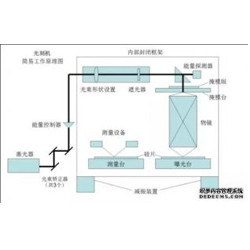The difference between an etching machine and a photolithography machine: the lithography machine prints the pattern, and then the etcher etches the part with the pattern (or no pattern) according to the printed pattern, leaving the remaining part. Etching is easier than lithography. If the construction on the silicon crystal is compared to the carpenter's work, the function of the photolithography machine is equivalent to the carpenter's marking on the wood with ink fountain, and the function of the etching machine is equivalent to the carpenter's construction on the wood with saws, chisels, axes and planes. The nature of etcher and lithography machine are the same, but the precision requirements are very different. Carpenters do fine work, usually to the millimeter line. The etching machine and photolithography machine for chip should be nano meter. Today's mobiles phones chips, such as hiskirin 970 and Qualcomm snapdragon 845, are TSMC's 10 nm technology. How small is 10 nanometers? For example. If a 0.05 mm diameter hair filament is cut into 5000 pieces in axial direction, the thickness of each piece is about 10 nm. Now the world's lithography machine is ASML company in the Netherlands, as small as 10 nanometers. TSMC bought all its lithography machines. ASML is actually the result of technical cooperation among the United States, the Netherlands and Germany. Because the research in this area is too difficult to complete alone. In addition to ASML, we are the only one in the world that is still working hard on high-end lithography machines.
We are under the technical embargo, can not buy his products, domestic Shanghai mass production is 90 nm lithography. There is a technical gap. In 2017, the "extreme ultraviolet" technology of Changchun Institute of Optics and mechanics made a breakthrough, which is expected to reach 22-32 nm, narrowing the technical gap.
I believe that in the near future, our scientific and technological personnel will be able to develop the world's lithography machine, no longer be stuck neck. The core technology, the key technology and the national heavy equipment must be based on ourselves. We should abandon our illusions and rely on ourselves to tackle key problems in science and technology.
Our etching machine technology has broken through. We can also produce 5-nanometer etcher independently. Now, the one with neck sticking is photolithography. In the process of chip processing, lithography lofting, etching machine construction, cleaning machine cleaning. Then it is repeated dozens of times. Generally, it takes about 500 processes to complete the integrated circuit of the chip, that is, the transistor. If the lofting can not reach the accuracy, the etching machine will lose its use.
What is a lithography machine
Also known as mask aligner, exposure system, lithography system, etc. The general lithography process includes cleaning and drying of silicon wafer surface, coating primer, spin coating photoresist, soft drying, alignment exposure, post drying, development, hard drying, etching, etc.
Photolithography refers to the process of using light to make a pattern (process); evenly glue the surface of a silicon wafer, and then transfer the pattern on the mask to the photoresist, and temporarily "copy" the device or circuit structure to the silicon chip.
The purpose of lithography
It makes the surface hydrophobic and enhances the adhesion between the substrate surface and photoresist.
Working principle of lithography machine
The above picture is a simple working principle diagram of the lithography machine. Next, a brief introduction to the role of each device in the figure below.
Measuring table, exposure table: the working table bearing silicon wafer, that is to say, double working table.
Beam corrector: correct the incident direction of the beam and make the laser beam parallel as far as possible.
Energy controller: control the energy of the final irradiation on the silicon wafer. Under exposure or over exposure will seriously affect the image quality.
Beam shape setting: set the beam to be circular, annular and other different shapes, and different beam states have different optical characteristics.
Sunshade: prevents light from reaching silicon wafers when exposure is not required.
Energy detector: detect whether the final incident energy of the beam meets the exposure requirements, and feed back to the energy controller for adjustment.
Mask: a glass plate with a circuit design inside that costs hundreds of thousands of dollars.
Mask stage: the device that carries the mask movement, and the motion control accuracy is nm level.
Objective lens: the objective lens is composed of more than 20 lenses. The main function of the objective lens is to reduce the circuit diagram on the mask in proportion, and then to compensate for various optical errors. The technical difficulty lies in the difficulty in the design of objective lens and the high requirement of precision.
Wafer: a wafer made of silicon crystals. Silicon wafers have many sizes. The larger the size, the higher the yield. As a digression, because the silicon wafer is round, it is necessary to cut a notch on the silicon wafer to confirm the coordinate system of the silicon wafer. According to the shape of the notch, it can be divided into two types, namely flat and notch.
Internal closed frame and shock absorber: isolate the working table from the external environment, keep the level, reduce the external vibration interference, and maintain stable temperature and pressure.
Classification of lithography machines
Generally, lithography machine can be divided into three types according to the simplicity of operation: manual, semi-automatic and full-automatic.
A manual: it refers to the adjustment mode of alignment, which is completed by manually adjusting the knob to change its x-axis, Y-axis and thita angle. It can be imagined that the alignment accuracy is not high;
B semi-automatic: refers to the alignment can be carried out through the electric shaft according to the CCD positioning tuning;
C automatic: it refers to the upload and download from the substrate. The exposure time and cycle are controlled by the program. The automatic lithography machine mainly meets the needs of the factory for processing capacity.
Lithography machine can be divided into three categories: near contact lithography, direct writing lithography and projection lithography. In the close contact mode, the pattern on the mask is reproduced by infinite proximity; in projection lithography, the structure on the mask is projected onto the surface of the substrate; while in direct writing, the beam is focused to a point, and any pattern processing is realized through moving stage or lens scanning. Optical projection lithography, with its advantages of high efficiency and no damage, has always been the mainstream lithography technology for integrated circuits.
Application of lithography
Lithography machine can be widely used in fabrication of micro nano fluidic chip, micro nano optical element, micro nano grating, nmems device and so on.
What is an etcher
In fact, the narrow sense is photolithography corrosion. Firstly, the photoresist is exposed by photolithography, and then the parts to be removed are removed by other methods. With the development of micro manufacturing technology, in a broad sense, etching has become a general term for stripping and removing materials by solution, reactive ions or other mechanical means, and has become a universal name for micromachining.
Principle of etching machine
Inductively coupled plasma etch (ICPE) is the result of chemical and physical processes. Its basic principle is that under the vacuum and low pressure, the RF generated by ICP RF power supply is output to the annular coupling coil, and a certain proportion of mixed etching gas is coupled to glow discharge to produce high-density plasma, and RF at the lower electrode is generated Under the action of RF, these plasmas bombard the substrate surface, and the chemical bond of semiconductor material in the pattern area of substrate is broken, and volatile substance is generated with etching gas, which is separated from the substrate in the form of gas, and then pumped away from the vacuum pipeline.

 中文(簡體)
中文(簡體)







